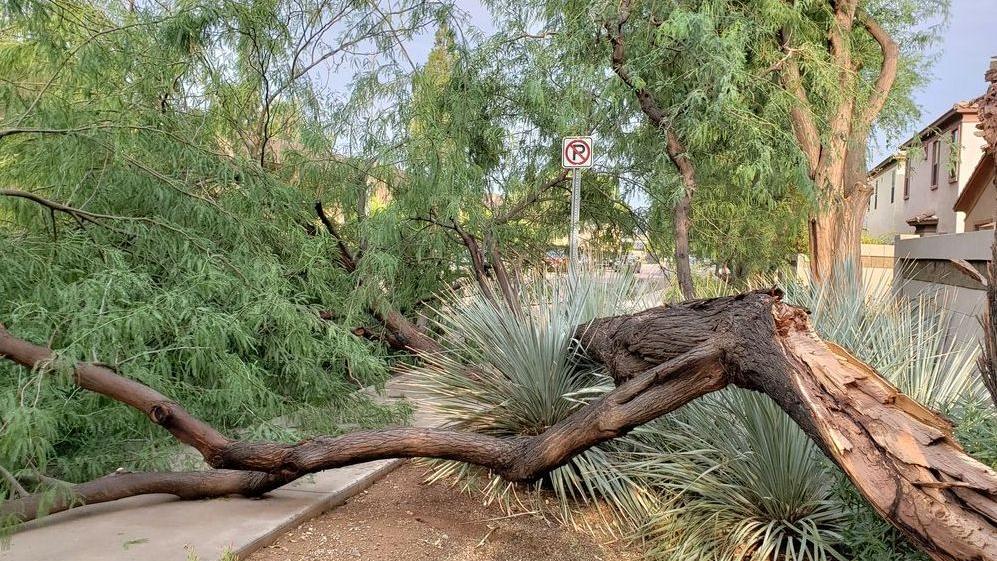Rosie Romero
Special to the Arizona Daily Star
The monsoon season is here. Whether or not we get rain is yet to be seen. However, even if we don’t receive the rain, we often experience strong winds. It’s a good idea to inspect your trees and ensure they are in good condition to withstand the storms.
Tips for growing healthy trees
Ensure the tree is a suitable fit for the location.
When trimming limbs leave the collar in place and don’t cut flush with the tree. Other tips include: Topping trees is harmful to the tree and does not enhance its look or function. Visually inspecting your trees for oversized or unbalanced limbs allows you to have them pruned before they break and cause damage.
iStock
The first key to having a healthy tree goes back to choosing the right tree for the right place and not putting an oversized tree in a small space, which lessens the tree’s chances of thriving. Constantly pruning a too-large tree to fit a too-small space increases the chances of damaging the tree. If you find yourself in this predicament, it may be time to replace the tree. There are a wide variety of low-water use trees that are suitable for the desert, and they come in every size.
People are also reading…
Provide adequate water
Good watering practices include:
1. Water slowly and deeply to the full depth of the root ball — 3 feet for mature trees.
2. Watch trees in the late afternoon for wilting. Water again only when the soil has dried out. Remember, water is often stored deeper in the soil, even when the surface soil is dry.
3. Use a soaker hose to supplement the drip system in extremely hot and dry conditions.
4. Once a month, run a longer turf cycle to flush salts and rejuvenate turf.
Correct pruning
Trees in our landscape require care to maintain their structural integrity and aesthetics. Pruning must be done with an understanding of tree biology, as improper pruning can cause lasting damage or shorten the tree’s lifespan.
The right reasons to prune include removing dead branches, improving the tree’s shape, and reducing the risk of large limb breakage. Pruning also helps let light through to the landscape below.
Light pruning, or removal of dead or weak limbs, can be done at any time of year. Heavier pruning should be done before spring growth so that the tree has time to recover before the summer sun and heat stress it.
There is more to pruning than lopping off a branch or two. A certified arborist is often the best choice for larger trees that need significant pruning and are too high to reach. Certified arborists understand the science behind the tree’s structure and apply best practices to shaping and pruning it.
Improper limb removal — Limbs are often removed by cutting the limb flush with the body of the tree. It is essential to leave the branch collar when removing a limb.
Lion-tailing — This is the practice where a tree is essentially stripped of most or all its interior branches and foliage, leaving only a minimal amount of growth at the end of the branch. Lion-tailing not only affects a tree’s aesthetics but also poses potential hazards, as the tree is unstable.
Topping — Taking the top off a tree makes for an ugly and stressed tree. Trees need their leaves for food, and removing the top can strip the tree of 50-100% of its leaf-bearing crown. Topping also leads to sunburn, decay, superficial branches, and bug infestation.
Exposing the trunk and bark of the tree — Pruning a tree too severely exposes the trunk to sunburn, which can cause the bark to split and lead to branch loss.
Monsoon tips
1. Shut off irrigation before high winds — saturated soil can lead to entire tree failure.
2. Know the signs of a hazardous tree — Take a moment to look at your trees. Are there limbs touching the house or other structures, or are there limbs that are out of proportion, making one side heavier than the other? A good visual inspection can alert you to potential damage that can be caused by trees that need care. Consult a certified arborist if needed.
3. Stake young trees — Always remove the bamboo pole that comes with the tree in the pot. Staking a young tree can give it stability in high winds. Use two or three stakes and set them a couple of feet out from the tree. Tie the tree to the stakes, leaving a little slack as the tree needs movement to build strength. Don’t leave a stake in place for more than two seasons. Check it often to ensure the stake bands still have some give.
Previous Rosie on the House guides are available on Tucson.com, including tree selection for the Arizona desert and low water-use plants and trees.
The top stories from Sunday’s Home+Life section in the Arizona Daily Star.
Join Rosie on the House every Saturday morning 8-11 on KTAR 92.3 FM and KNST 790 AM from 10-11 a.m.
Do you have questions about your house, home, castle or cabin? Reach us by phone at 1-888-767-4348 or email info@rosieonthehouse.com. Follow us on Facebook, YouTube, and Instagram.
Make your house a home
For the holidays: Get inspiring home and gift ideas – sign up now!
